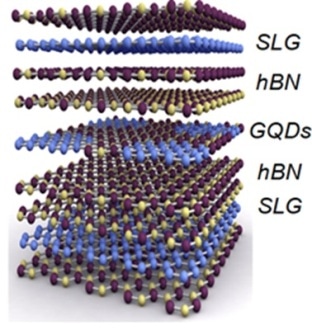Mar 7 2019
An innovative technology capable of combining the fabrication processes of planar and vertical heterostructures, with the aim of assembling graphene-based superior-quality single-electron transistors, has been developed by scientists at the Higher School of Economics, Manchester University, the Ulsan National Institute of Science and Technology, and the Korea Institute of Science and Technology.
 The schematic structure of the devices (Image credit: Davit Ghazaryan)
The schematic structure of the devices (Image credit: Davit Ghazaryan)
This new technology could be capable of providing more opportunities for research on two-dimensional materials by introducing a wider platform for the study of different devices and physical phenomena. The study on this technology features in an article in the journal Nature Communications.
The study proved the possibility of successfully synthesizing superior-quality graphene quantum dots (GQDs) in a matrix of monolayer hexagonal boron nitride (hBN), irrespective of whether they were randomly distributed or ordered. When the entire structure was treated by the heat in the methane gas (CH4), the growth of GQDs inside the layer of hBN was revealed to be catalytically supported by the platinum (Pt) nanoparticles spread in-between the hBN and supporting oxidized silicon (SiO2) wafer.
It was further demonstrated that graphene islands grow in the hBN with passivated edge states because of the same lattice structure (hexagonal) and small lattice disparity (~1.5%) of graphene and hBN, thus leading to the creation of perfect quantum dots embedded within the hBN monolayer.
Such planar heterostructures combined with the help of typical dry-transfer as mid-layers into the normal structure of vertical tunneling transistors (Si/SiO2/hBN/Gr/hBN/GQDs/hBN/Gr/hBN) were analyzed via tunnel spectroscopy at low temperatures (3He, 250 mK). (Here, Gr stands for monolayer graphene and GQDs denotes the layer of hBN with the embedded graphene quantum dots.) The study established where the manifestation of the well-recognized phenomena of the Coulomb blockade for every single graphene quantum dot as a distinct, single electron transmission channel takes place.
Although the outstanding quality of our single electron transistors could be used for the development of future electronics, this work is most valuable from a technological standpoint as it suggests a new platform for the investigation of physical properties of various materials through a combination of planar and van der Waals heterostructures.
Davit Ghazaryan, Study Co-Author, Associate Professor, HSE Faculty of Physics
Ghazaryan is also a Research Fellow at the Institute of Solid State Physics (RAS).